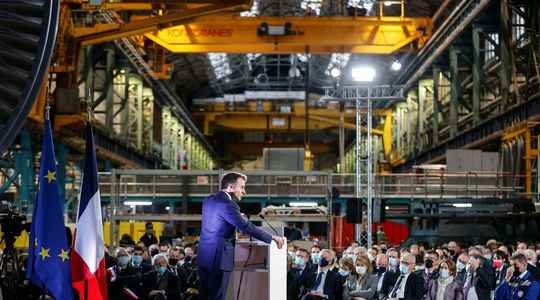“The world of tomorrow will be more electric (…) We must be able to produce up to 60% more electricity than today. And the key, to do this in the safest way, it is to develop renewable energies and nuclear power”, declared this Thursday from Belfort Emmanuel Macron, where the almost-candidate for his re-election unveiled a plan for the revival of civil nuclear power and the development of renewable energies (wind, solar and hydroelectric). Here are the details.
- Six new reactors by 2050, eight more optional
First announcement, expected: Emmanuel Macron wants to build six new next-generation EPR nuclear reactors by 2050, and is considering eight more. The commissioning of the first EPR2 is planned for 2035.
The goal is to reach “25 gigawatts of new nuclear capacity by 2050”, making it possible to meet increased electricity needs by the middle of the century. These new reactors will be supplemented by small modular reactors (SMR) and “innovative” reactors producing less waste, specified the President of the Republic, who promised “massive public funding of several tens of billions of euros” for this program and “will take its responsibilities to secure the financial situation of EDF”, now heavily indebted. An “interministerial program management” will be dedicated to new projects.
- Extension of “all reactors that can be extended”
The Head of State intends to “extend all the reactors that can be extended”, beyond 50 years if possible, he also announced in Belfort. Until now, France had planned to close 12 additional reactors, after the two in Fessenheim already stopped, an objective engraved in its multi-annual energy program (PPE).
“I made two strong decisions: to extend all the nuclear reactors that can be extended, without giving up anything on safety” and “that no nuclear reactor in a state of production should be closed in the future (…) except for safety reasons”, he continued, specifying that he had asked EDF “to study the conditions for extension beyond 50 years”.
Because it’s not just nuclear, France will also have around fifty wind farms at sea to “aim for 40 gigawatts in service by 2050”, a very ambitious threshold, due to a delay on ignition. To date, the most advanced park remains that of Saint-Nazaire (Loire-Atlantique), with 80 wind turbines expected to enter service within the year. In the immediate future, France has planned the allocation of 1 GW annually by 2024.
In addition, the Head of State wants to double the capacity of onshore wind power, a slower increase than expected. For the president, “we must be reasonable in the objectives” and spread their development over time, doubling the capacities in 30 years rather than in 10 years as planned so far.
- Multiply solar power by 10
In order to double the production from renewable electric energies by 2030, Emmanuel Macron finally called for multiplying “by almost 10 the installed power” of solar energy “to exceed 100 gigawatts”. “We need to massively develop renewable energies”, he said, “simply because it is the only way to meet our immediate electricity needs where it takes 15 years to build a nuclear reactor”.
Emmanuel Macron also cited the need to continue investing in hydroelectric dams and thermal renewable energies, such as biomass and biogas. The France 2030 plan “will devote one billion euros to innovation in renewable energies”, he said.
